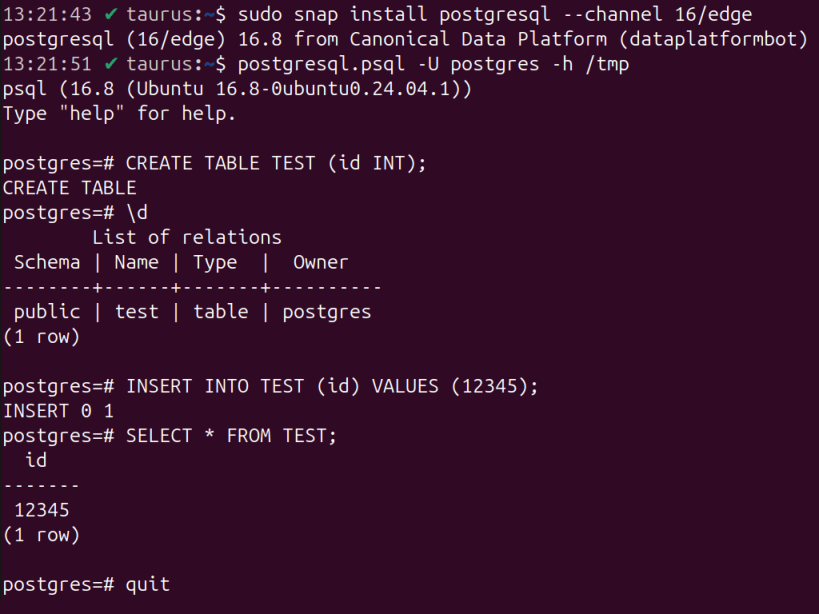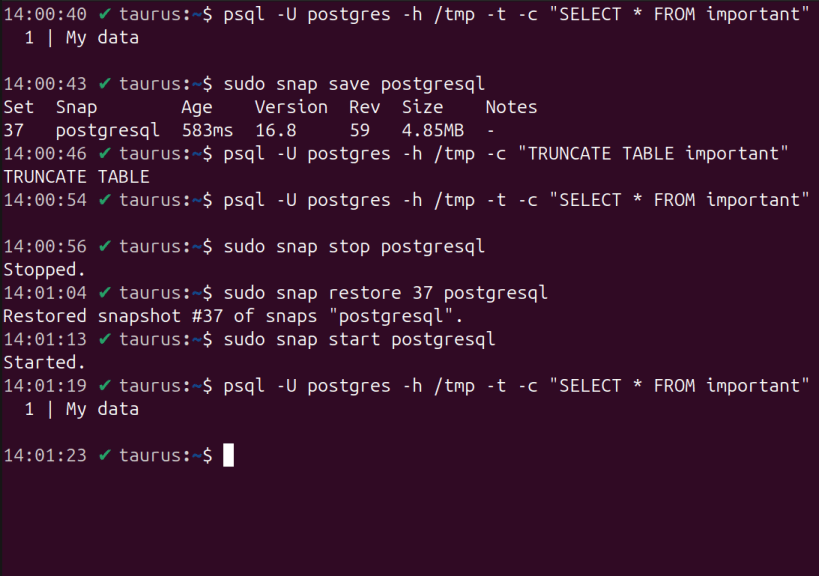


PostgreSQL is a powerful, open source object-relational database system. It has more than 20 years of active development and a proven architecture that has earned it a strong reputation for reliability, data integrity, and correctness.
Install the snap
If you are an Ubuntu user, snapd is pre-installed and ready to go on all recent Ubuntu releases. Simply click on the drop-down menu at the upper right-hand corner of this page, select your channel of choice (e.g. 16/stable), and paste the command in your terminal, e.g.:
sudo snap install postgresql
If you are not using Ubuntu, scroll further down this page to find installation instructions for other distributions.
Use the snap
Once installed, PostgreSQL will start automatically. To log in, run:
postgresql.psql -U postgres -h /tmp
It is highly recommended to set a new password in the postgres console:
\password postgres
For convenience, the snap alias psql is pre-created:
psql -U postgres -h /tmp
See more PostgreSQL snap documentation on GitHub: https://github.com/canonical/postgresql-snap/blob/16/edge/docs
You are about to open
Do you wish to proceed?
Thank you for your report. Information you provided will help us investigate further.
There was an error while sending your report. Please try again later.
Snaps are applications packaged with all their dependencies to run on all popular Linux distributions from a single build. They update automatically and roll back gracefully.
Snaps are discoverable and installable from the Snap Store, an app store with an audience of millions.

Snap can be installed from the command line on openSUSE Leap 15.x and Tumbleweed.
You need first add the snappy repository from the terminal. Choose the appropriate command depending on your installed openSUSE flavor.
Tumbleweed:
sudo zypper addrepo --refresh https://download.opensuse.org/repositories/system:/snappy/openSUSE_Tumbleweed snappy
Leap 15.x:
sudo zypper addrepo --refresh https://download.opensuse.org/repositories/system:/snappy/openSUSE_Leap_15.6 snappy
If needed, Swap out openSUSE_Leap_15. for, openSUSE_Leap_16.0 if you’re using a different version of openSUSE.
With the repository added, import its GPG key:
sudo zypper --gpg-auto-import-keys refresh
Finally, upgrade the package cache to include the new snappy repository:
sudo zypper dup --from snappy
Snap can now be installed with the following:
sudo zypper install snapd
You then need to either reboot, logout/login or source /etc/profile to have /snap/bin added to PATH.
Additionally, enable and start both the snapd and the snapd.apparmor services with the following commands:
sudo systemctl enable --now snapd
sudo systemctl enable --now snapd.apparmor
To install PostgreSQL, simply use the following command:
sudo snap install postgresql
Browse and find snaps from the convenience of your desktop using the snap store snap.

Interested to find out more about snaps? Want to publish your own application? Visit snapcraft.io now.